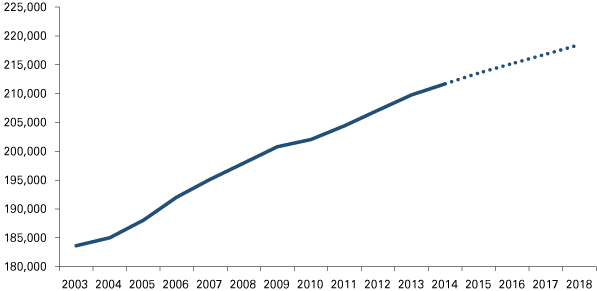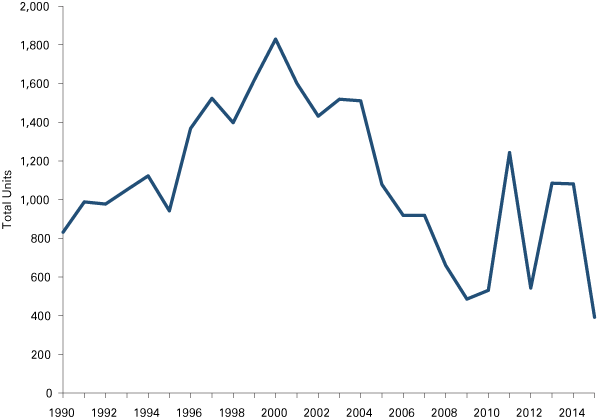Lafayette Forecast 2016
Community Development Regional Extension Educator, Purdue University
The Lafayette Metropolitan Statistical Area (MSA) continuously finds ways to shine regardless of national and statewide economic concerns. In 2015, the manufacturing and transportation, trade and logistics industries had strong growth, which was a contributing factor in the dropping unemployment rates, increased employment, expansion of firms and attraction of new businesses to the area.
Since the Great Recession, the Lafayette MSA (which includes Tippecanoe, Benton and Carroll counties) has rebounded in a sustainable fashion—slow and steady (albeit frustratingly slow at times). Looking toward the future, there is little doubt that growth will continue thanks to its diverse industry portfolio and strong university connection. These strengths, coupled with its geographic location, make it an attractive area to live and work.
Figure 1 shows continuous population growth for the MSA—an addition of approximately 3,000 people per year since 2003. The projected 2015 population is 213,571. The Indiana University Center for Econometric Model Research anticipates annual population growth of 0.8 percent in the region through 2018.
Figure 1: Annual Lafayette MSA Population

Note: Data for 2015 through 2018 are projections.
Source: U.S. Census Bureau and Indiana University Center for Econometric Model Research
Labor
The Lafayette MSA maintained a lower unemployment rate than Indiana and the United States between August 2014 and September 2015 (see Table 1). The average 0.8 percentage point spread in unemployment rates is indicative of the diverse and strong economy within the Lafayette MSA. The preliminary September unemployment rate puts the Lafayette MSA as the fourth-lowest rate among all Indiana MSAs. As predicted, the unemployment rate is beginning to dip into the upper 3 percent range, reflecting rates seen in 2006 and 2007. In the next three years, MSA employment is expected to have steady growth, thus it is likely that the unemployment rate will stay in the upper 3 percent range.
Table 1: Labor Force and Unemployment for the Lafayette MSA
| Year | Month | Labor Force | Employment | Unemployed | Lafayette MSA Unemployment Rate | Indiana Unemployment Rate | U.S. Unemployment Rate |
|---|---|---|---|---|---|---|---|
| 2014 | August | 102,374 | 97,057 | 5,317 | 5.2% | 6.0% | 6.3% |
| September | 106,900 | 101,924 | 4,976 | 4.7% | 5.5% | 5.7% | |
| October | 109,097 | 103,894 | 5,203 | 4.8% | 5.6% | 5.5% | |
| November | 109,111 | 103,630 | 5,481 | 5.0% | 5.9% | 5.5% | |
| December | 107,983 | 102,903 | 5,080 | 4.7% | 5.7% | 5.4% | |
| Annual | 105,714 | 100,282 | 5,342 | 5.1% | 6.0% | 6.2% | |
| 2015 | January | 107,202 | 101,223 | 5,979 | 5.6% | 6.7% | 6.1% |
| February | 106,950 | 101,695 | 5,255 | 4.9% | 6.1% | 5.8% | |
| March | 105,909 | 100,798 | 5,111 | 4.8% | 5.9% | 5.6% | |
| April | 105,951 | 102,021 | 3,930 | 3.7% | 4.6% | 5.1% | |
| May | 105,996 | 101,512 | 4,484 | 4.2% | 4.8% | 5.3% | |
| June | 104,391 | 99,517 | 4,874 | 4.7% | 4.8% | 5.5% | |
| July | 104,292 | 99,431 | 4,861 | 4.7% | 4.8% | 5.6% | |
| August | 104,763 | 100,459 | 4,304 | 4.1% | 4.4% | 5.2% | |
| September* | 108,220 | 104,324 | 3,896 | 3.6% | 4.0% | 4.9% |
*Preliminary data
Source: U.S. Bureau of Labor Statistics
A year-over-year comparison between August 2014 and 2015 shows that employment increased by 3,400 workers and unemployment dropped by 1,000.
Table 2 looks specifically at the employment picture between 2014 and 2015 in the Lafayette MSA. Last year, it was anticipated that most of the employment growth would stem from professional and business services, and there was mixed opinion on how the manufacturing industry would perform.
Table 2: Lafayette MSA Employment
| Industry | 2015* | Change since 2014 | Percent Change, 2014-2015 |
|---|---|---|---|
| Total Nonfarm | 100,033 | 767 | 0.8% |
| Total Private | 73,222 | 1,631 | 2.3% |
| Goods-Producing | 20,867 | 675 | 3.3% |
| Manufacturing | 17,578 | 603 | 3.6% |
| Mining, Logging and Construction | 3,289 | 72 | 2.2% |
| Service-Providing | 79,167 | 92 | 0.1% |
| Trade, Transportation and Utilities | 15,056 | 539 | 3.7% |
| Private Educational and Health Services | 11,633 | 125 | 1.1% |
| Leisure and Hospitality | 9,400 | 125 | 1.3% |
| Professional and Business Services | 8,189 | -44 | -0.5% |
| Financial Activities | 3,500 | 42 | 1.2% |
| Information | 878 | 3 | 0.3% |
| Other Services | 3,700 | 167 | 4.7% |
| Government | 26,811 | -864 | -3.1% |
*January through September data annualized for 2015. September data are preliminary.
Source: U.S. Bureau of Labor Statistics
Thus far in 2015, nearly all industries have experienced employment growth. The only exceptions were professional and business services and government. Manufacturing led the way with an increase of 600 workers (3.6 percent), followed by the trade, transportation and utilities industry with 540 additional workers (3.7 percent).
In the past year, the manufacturing industry gained an additional 3 percentage points (now equaling 18 percent) of the Lafayette MSA’s employment share. Meanwhile, the trade, transportation and utilities industry comprises 15 percent of the area’s employment. As we enter the last quarter of 2015, the latest economic data has not been favorable regarding business investments, trade and government purchases. That does not bode well for 2016.
Already in 2015, Caterpillar and Oerlikon Fairfield have announced workforce reductions. However, housing and consumer expenditures have remained strong, which explains why Subaru of Indiana Automotive has a $140 million expansion plan involving 1,700 new workers by 2017. Other major business investments include Tate and Lyle’s $65 million expansion, and there have been several reports of new businesses or expansion of existing businesses within Purdue’s Research Park.
The two industries with declines thus far in 2015 are government and professional business services. Government’s loss of employment was primarily at the state government level—which includes state agencies and universities. Local government employment actually increased modestly. The slight drop in employment numbers for the professional and business industries may reflect the inclusion of temporary services, which tends to be volatile.
In 2016, it is expected that employment growth will closely mirror 2015 results, potentially gaining an additional 3,200 workers. A pullback in the manufacturing sector might occur; however, it may be offset by other industries’ growth given the news reports of business growth in 2015.
Between the first quarter of 2014 and the first quarter of 2015, average weekly wages increased 4.6 percent within the Lafayette MSA. Fifteen out of the 18 major sectors (one was non-disclosed) had positive wage increases, ranging from 0.2 percent (educational services) to 12.2 percent (finance and insurance), as seen in Table 3. This wage growth was better than anticipated, thanks to the increased number of employees and wages paid in manufacturing, as well as higher wages given in the finance, agriculture and information industries. The latter three industries did have modest employment growth—thus highlighting the increase in wages.
Table 3: Average Weekly Wages in the Lafayette MSA
| Industry | Average Weekly Wage, 2015 Q1 | Change in Jobs since 2014 Q1 | Change in Average Weekly Wage since 2014 Q1 |
|---|---|---|---|
| Total | $846 | 3.0% | 4.6% |
| Utilities* | $1,570 | 10.2% | -5.0% |
| Management of Companies and Enterprises | $1,418 | -3.5% | 2.2% |
| Manufacturing* | $1,414 | 4.9% | 10.0% |
| Finance and Insurance | $1,172 | 10.6% | 12.2% |
| Wholesale Trade | $1,074 | 2.1% | 4.5% |
| Professional, Scientific, and Technical Services | $1,073 | 0.4% | -2.7% |
| Educational Services* | $995 | 3.1% | 0.2% |
| Health Care and Social Services | $832 | 1.0% | 2.3% |
| Transportation and Warehousing | $806 | 3.6% | 2.3% |
| Construction | $799 | 9.7% | 6.0% |
| Public Administration | $779 | 0.4% | -2.7% |
| Agriculture, Forestry, Fishing and Hunting | $745 | -2.7% | 10.7% |
| Information | $719 | -9.5% | 11.8% |
| Real Estate and Rental and Leasing | $628 | 2.4% | 5.2% |
| Other Services (Except Public Administration) | $580 | 3.9% | 1.6% |
| Retail Trade | $451 | 3.6% | 3.0% |
| Administrative and Support and Waste Management and Remediation Services | $447 | 6.6% | 3.5% |
| Accommodation and Food Services | $272 | 0.5% | 5.4% |
| Arts, Entertainment, and Recreation | $249 | 1.3% | 7.8% |
* Indicates that some county data were excluded due to confidentiality restrictions.
Note: Data for mining were nondisclosable.
Source: STATS Indiana, using Quarterly Census of Employment and Wages data
In 2016, due to mixed signals regarding how the Lafayette MSA’s economic climate will perform, it is predicted that average annual wages will have marginal growth.
Research shows that per capita personal income (PCPI) in Indiana and the Lafayette MSA historically lags the United States due to a different occupational mix within the MSA and the fact that Indiana’s highest-earning tier of occupations tends to be paid less than similar occupations elsewhere, regardless of cost of living factors.1 The most recent PCPI data for the Lafayette MSA at the time of this writing was 2013, which showed the MSA’s PCPI being 77 percent of the national figure. Growth in the Lafayette MSA’s PCPI was very limited in 2013—only increasing by 0.7 percent. In 2014, it’s projected to increase by 2.0 percent and again by 4.2 percent in 2015.
Housing
The real estate market in the Lafayette MSA continues to tighten slightly, with an uptick in closed sales (10.6 percent), a drop in new listings (-5.9 percent) and a decrease in home inventory (-6.4 percent). Table 4 compares year-to-date (January through September) 2015 figures with 2014. Among the three counties that make up the Lafayette MSA, all experienced higher median home price values with Carroll County having the most notable increase (15.9 percent). In Tippecanoe County, the change in real estate activity has been less volatile than its sister MSA counties. Carroll County has dropped its inventory of homes on the market by 19.5 percent and now has a 10-month supply of housing (-20.9 percent). Benton County dropped its housing inventory by 15 percent and now has 6.6 months’ worth of housing inventory to sell.
Table 4: Lafayette MSA Residential Real Estate Sales
| Lafayette MSA | Benton County | Carroll County | Tippecanoe County | |||||||||
|---|---|---|---|---|---|---|---|---|---|---|---|---|
| 2014 | 2015 | Change | 2014 | 2015 | Change | 2014 | 2015 | Change | 2014 | 2015 | Change | |
| New Listings | 2,811 | 2,646 | -5.9% | 114 | 114 | 0.0% | 263 | 226 | -14.1% | 2,434 | 2,306 | -5.3% |
| Closed Sales | 1,772 | 1,959 | 10.6% | 65 | 62 | -4.6% | 115 | 115 | 0.0% | 1,592 | 1,751 | 10.0% |
| Median Sales Price | n/a | n/a | n/a | $66,500 | $70,000 | 5.3% | $104,800 | $121,500 | 15.9% | $131,750 | $141,000 | 7.0% |
| Months’ Supply of Inventory | n/a | n/a | n/a | 11.6 | 6.6 | -43.1% | 12.9 | 10.2 | -20.9% | 5.1 | 5.0 | -2.0% |
| Inventory of Homes for Sale | 1,110 | 1,039 | -6.4% | 60 | 51 | -15.0% | 174 | 140 | -19.5% | 876 | 848 | -3.2% |
Note: Data reflect January to September for both years. Months’ supply of inventory and inventory of homes for sale are September values.
Source: Indiana Association of Realtors data
Nationally, housing trends are similar to what the Lafayette MSA has experienced. Existing home prices have increased, the pace of home sales is at its second-highest value since 2007, and the inventory of homes has decreased with a national unsold inventory at 4.8 months’ supply. The demand for housing has been strong despite stronger growth in housing prices relative to wages.
Given the past trends of a gradually tightening existing housing market, it provides some insight into why the region saw an uptick in housing permits issued in 2013 and 2014. However, only half of these permits were for single-family housing, reversing more recent trends of tepid interest in multi-family dwellings (five or more families). Thus far in 2015, permit issuances in Tippecanoe County are indicating a contraction in permits issued (see Figure 2).
Figure 2: Lafayette MSA Residential Building Permits

Note: 2015 data reflects year-to-date figures through September 2015 for Tippecanoe County only.
Source: STATS Indiana, using U.S. Census Bureau data
In 2016, the strong demand for housing will likely continue. The increase in housing permits will yield new housing structures in the Lafayette MSA; however, is it enough to satisfy the needs of the existing population as well as new entrants to the MSA? It is expected that median sales prices will likely continue to rise as the area reduces its inventory of existing homes for sale.
Conclusion
Overall, the economic and housing activity in the Lafayette MSA during 2015 was very positive, performing better than expected—especially in manufacturing. Compared to this time last year, there have been fewer expansion announcements among larger companies, but smaller companies are increasingly attracted to Purdue’s Research Park.
For 2016, it is expected that the forward momentum will continue, but the growth may be less dependent on the manufacturing industry. Individuals will continue to be attracted to the area, new jobs will be created, wages will increase and the demand for housing will remain. Ideally, 2016 will match or exceed 2015’s performance; however, dismal recent state and national economic data forces one to have guarded optimism despite the tremendous assets in the Lafayette MSA.
Notes
- For more research on differences between the U.S. and Indiana PCPI, see “Occupational Hazard: Why Indiana’s Wages Lag the Nation” and "Finding New Cheese: Why Indiana’s Per Capita Personal Income Lags (and How to Fix It)" in the Indiana Business Review.




